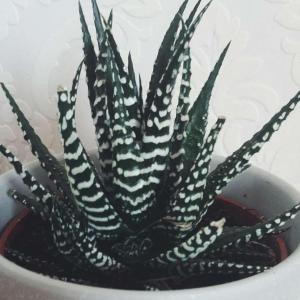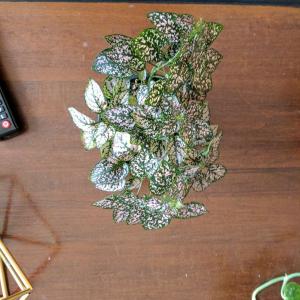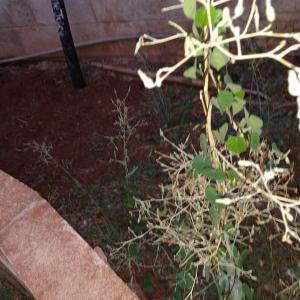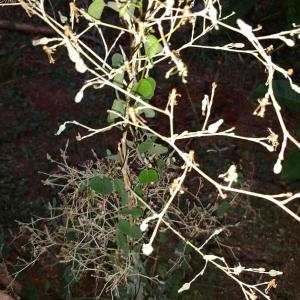文章
Dummer. ゛☀
2017年07月28日

Family - Ranunculaceae
Stems - Single from a small woody caudex, erect, herbaceous, terete, Variously pubescent but typically with appressed retrorse pubescence, typically simple but vigorous plant will branch, to +1m tall.

Leaves - Alternate, petiolate below, short petiolate to sessile above. Petioles to +/-15cm long, pubescent, flattened adaxially. Blades palmately divided (the main divisions divided again), to +/-9cm long and broad, pubescent. Divisions of the lowest leaves to 5mm broad. Divisions of the upper leaves linear, subacute to acute.

Inflorescence - Terminal bracteate raceme to +30cm long. Each flower subtended by at least a small subulate bract. Lower flowers with foliaceous bracts. Pedicels to 1.5cm long, typically densely retrorse pubescent. Each flower with a pair of opposite bracts at the base. Bracts subulate-linear, to 6mm long, 1mm broad, erect.
Flowers - Petals 5, variously shaped, blue to white. 3 petals forming the spur of the corolla. Lateral petals bearded, deeply notched. Lateral spur petals with cylindric bases for holding nectar. Central spur petal linear and thin. Stamens many, surrounding the pistils. Filaments glabrous, greenish-white, compressed, to 6mm long, some curled, others straight. Anthers olive-greenish brown, 1.8-2mm long. Pistils 3, lanate, 5mm long in flower, tapering to the apex and a short glabrous style and stigma (to 1mm long). Sepals 5, violet blue to white, free, to 1cm long, 6-7mm broad, mostly rounded at the apex, glabrous internally, pubescent externally. Spur sepal to 2cm long, rugose.

Flowering - May - June.
Habitat - Limestone glades, prairies, and rocky woods, roadsides, railroads in prairies.
Origin - Native to U.S.
Other info. - This showy species an be found throughout much of Missouri but is most abundant in the Ozark region of the state. The brilliant blue flowers are easy to spot growing on glades and along rocky roadsides.
This species and another, D. virescens Nutt., are now considered to be the same species or, at most, subspecies of D. carolinianum. Where the two plants overlap in the wild, they integrade. The resulting plants have light blue flowers as shown below:
Stems - Single from a small woody caudex, erect, herbaceous, terete, Variously pubescent but typically with appressed retrorse pubescence, typically simple but vigorous plant will branch, to +1m tall.

Leaves - Alternate, petiolate below, short petiolate to sessile above. Petioles to +/-15cm long, pubescent, flattened adaxially. Blades palmately divided (the main divisions divided again), to +/-9cm long and broad, pubescent. Divisions of the lowest leaves to 5mm broad. Divisions of the upper leaves linear, subacute to acute.

Inflorescence - Terminal bracteate raceme to +30cm long. Each flower subtended by at least a small subulate bract. Lower flowers with foliaceous bracts. Pedicels to 1.5cm long, typically densely retrorse pubescent. Each flower with a pair of opposite bracts at the base. Bracts subulate-linear, to 6mm long, 1mm broad, erect.
Flowers - Petals 5, variously shaped, blue to white. 3 petals forming the spur of the corolla. Lateral petals bearded, deeply notched. Lateral spur petals with cylindric bases for holding nectar. Central spur petal linear and thin. Stamens many, surrounding the pistils. Filaments glabrous, greenish-white, compressed, to 6mm long, some curled, others straight. Anthers olive-greenish brown, 1.8-2mm long. Pistils 3, lanate, 5mm long in flower, tapering to the apex and a short glabrous style and stigma (to 1mm long). Sepals 5, violet blue to white, free, to 1cm long, 6-7mm broad, mostly rounded at the apex, glabrous internally, pubescent externally. Spur sepal to 2cm long, rugose.

Flowering - May - June.
Habitat - Limestone glades, prairies, and rocky woods, roadsides, railroads in prairies.
Origin - Native to U.S.
Other info. - This showy species an be found throughout much of Missouri but is most abundant in the Ozark region of the state. The brilliant blue flowers are easy to spot growing on glades and along rocky roadsides.
This species and another, D. virescens Nutt., are now considered to be the same species or, at most, subspecies of D. carolinianum. Where the two plants overlap in the wild, they integrade. The resulting plants have light blue flowers as shown below:
0
0
成长记
stureburk
2017年07月27日
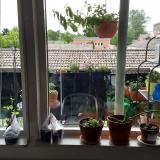
Found this sneaky fellow in a flowerpot that is nowhere near my Jade plant. It's a mystery 🕵️






2
0
stureburk:@Abby Gill Really seems like it. Although it feels a bit weird that they are doing better by themselves than with me bothering them. Lessons to be learned by that I guess.
Abby Gill:Haha looks like your plants are starting to propogate for you.
文章
Dummer. ゛☀
2017年07月27日

Family - Lamiaceae
Stems - To 50cm tall, multiple from base, erect to ascending, herbaceous, branching, 4-angled. Entire plant covered with very dense grey lanate pubescence.

Leaves - Opposite, decussate, petiolate below to subsessile above. Petiole to +8cm long. Blade elliptic to lanceolate, to +15cm long, +6cm broad, acute, tapering to base, crenate, margins slightly sinuous.
Inflorescence - Terminal dense spikiform arrangement of verticillasters. Flowers sessile, subtended by reduced leaves(foliaceous bracts).

Flowers - Corolla purple with some mottling internally, bilabiate. Corolla tube 7-8mm long, pubescent externally. Upper lip single, shallowly 3-lobed to entire at apex, 5mm long, 4-5mm broad. Lower lip 3-lobed. Two lateral lobes shallow, much smaller than central lobe. Central lobe 6-8mm long, 5mm broad. Stamens 4, didynamous, slightly exserted from upper lip of corolla. Filaments adnate at apex of corolla tube, dense pubescent, purple. Anthers purple, 1.1mm broad. Style 8mm long, glabrous, white to lilac, slightly exserted. Stigma 2-lobed. Ovary of 4 nutlets. Calyx tube to 8mm long, 5-lobed. Lobes subequal, acute, acuminate, to 2.5mm long, 2mm broad at base.

Flowering - July - September.
Habitat - Cultivated and persisting around old homesites and vacant lots.
Origin - Native to Eurasia.
Other info. - This is an attractive perennial plant which is cultivated in our area. It is not officially recorded as escaped in our area but there are persistent patches of the plant in the Ozarks which are doing quite well. The soft pubescence and striking flowers make it an interesting garden plant. The flowers are also much liked by flying insects. Propagation is by division. The plant prefers full sun which is obvious from the protective layer of pubescence covering the entire plant.
Stems - To 50cm tall, multiple from base, erect to ascending, herbaceous, branching, 4-angled. Entire plant covered with very dense grey lanate pubescence.

Leaves - Opposite, decussate, petiolate below to subsessile above. Petiole to +8cm long. Blade elliptic to lanceolate, to +15cm long, +6cm broad, acute, tapering to base, crenate, margins slightly sinuous.
Inflorescence - Terminal dense spikiform arrangement of verticillasters. Flowers sessile, subtended by reduced leaves(foliaceous bracts).

Flowers - Corolla purple with some mottling internally, bilabiate. Corolla tube 7-8mm long, pubescent externally. Upper lip single, shallowly 3-lobed to entire at apex, 5mm long, 4-5mm broad. Lower lip 3-lobed. Two lateral lobes shallow, much smaller than central lobe. Central lobe 6-8mm long, 5mm broad. Stamens 4, didynamous, slightly exserted from upper lip of corolla. Filaments adnate at apex of corolla tube, dense pubescent, purple. Anthers purple, 1.1mm broad. Style 8mm long, glabrous, white to lilac, slightly exserted. Stigma 2-lobed. Ovary of 4 nutlets. Calyx tube to 8mm long, 5-lobed. Lobes subequal, acute, acuminate, to 2.5mm long, 2mm broad at base.

Flowering - July - September.
Habitat - Cultivated and persisting around old homesites and vacant lots.
Origin - Native to Eurasia.
Other info. - This is an attractive perennial plant which is cultivated in our area. It is not officially recorded as escaped in our area but there are persistent patches of the plant in the Ozarks which are doing quite well. The soft pubescence and striking flowers make it an interesting garden plant. The flowers are also much liked by flying insects. Propagation is by division. The plant prefers full sun which is obvious from the protective layer of pubescence covering the entire plant.
0
0
文章
Dummer. ゛☀
2017年07月27日

Family - Lamiaceae
Stems - Multiple from the base, erect to ascending, from fibrous roots, 4-angled, typically purple at the base and nodes, glabrous, branching, to +/-15cm tall, herbaceous, glandular punctate (use a lens to see). Entire plant has a strong mint fragrance.

Leaves - Opposite, decussate, sessile, linear to linear-spatulate, to 1.5cm long, 3mm broad, entire, glabrous, rounded to subacute at the apex, densely glandular punctate on both surfaces.
Inflorescence - Single axillary flowers. Pedicels to +/-5mm long, glabrous.

Flowers - Corolla purplish (very rarely all white), bilabiate, 1.2cm long, pubescent externally, contracted and brown at the base in the calyx-covered portion. Upper lip single-lobed. The lobe deflexed, 3-4mm broad, 2-3mm long, emarginate. Lower lip 3-lobed. Lobes rounded, 2mm long and broad. The center lobe slightly larger than the laterals. Stamens 4, didynamous, 2 attached in the basal 1/4 of the corolla tube, 2 attached in the apical 1/4 of the corolla tube and slightly exserted. Filaments whitish and glabrous, to +3mm long. Anthers lilac, bilobed, 1mm long. Style white (lilac at the apex), glabrous, to 1cm long. Stigma unequally 2-lobed. Ovary green, glabrous, deeply 4-parted, .5mm long. Calyx bilabiate. Calyx tube to 4mm long, glandular punctate, with 13 ribs, greenish-purple. Upper lip 3-lobed. Lobes acuminate, 1.1-1.2mm long. Lower lip 2-lobed, lobes equal or slightly longer than upper lobes, acuminate. Calyx with a ring of floccose hairs at the summit of the tube internally.

Flowering - May - October.
Habitat - Limestone glades and knobs, rocky open ground, wet meadows along spring branches, gravel bars, bluffs escarpments.
Origin - Native to U.S.
Other info. - This little species is very common in the Ozarks of Missouri. The plant is more often smelled than seen. Plant hunters strolling through the glades of Missouri often step on the plant releasing a very strong mint flavor into the air. The smell is unmistakable. Because the plant has thin stems and thin leaves it often gets overlooked until that smell fills the air. Chewing on the plant gives you fresh breath that will last for hours.
Stems - Multiple from the base, erect to ascending, from fibrous roots, 4-angled, typically purple at the base and nodes, glabrous, branching, to +/-15cm tall, herbaceous, glandular punctate (use a lens to see). Entire plant has a strong mint fragrance.

Leaves - Opposite, decussate, sessile, linear to linear-spatulate, to 1.5cm long, 3mm broad, entire, glabrous, rounded to subacute at the apex, densely glandular punctate on both surfaces.
Inflorescence - Single axillary flowers. Pedicels to +/-5mm long, glabrous.

Flowers - Corolla purplish (very rarely all white), bilabiate, 1.2cm long, pubescent externally, contracted and brown at the base in the calyx-covered portion. Upper lip single-lobed. The lobe deflexed, 3-4mm broad, 2-3mm long, emarginate. Lower lip 3-lobed. Lobes rounded, 2mm long and broad. The center lobe slightly larger than the laterals. Stamens 4, didynamous, 2 attached in the basal 1/4 of the corolla tube, 2 attached in the apical 1/4 of the corolla tube and slightly exserted. Filaments whitish and glabrous, to +3mm long. Anthers lilac, bilobed, 1mm long. Style white (lilac at the apex), glabrous, to 1cm long. Stigma unequally 2-lobed. Ovary green, glabrous, deeply 4-parted, .5mm long. Calyx bilabiate. Calyx tube to 4mm long, glandular punctate, with 13 ribs, greenish-purple. Upper lip 3-lobed. Lobes acuminate, 1.1-1.2mm long. Lower lip 2-lobed, lobes equal or slightly longer than upper lobes, acuminate. Calyx with a ring of floccose hairs at the summit of the tube internally.

Flowering - May - October.
Habitat - Limestone glades and knobs, rocky open ground, wet meadows along spring branches, gravel bars, bluffs escarpments.
Origin - Native to U.S.
Other info. - This little species is very common in the Ozarks of Missouri. The plant is more often smelled than seen. Plant hunters strolling through the glades of Missouri often step on the plant releasing a very strong mint flavor into the air. The smell is unmistakable. Because the plant has thin stems and thin leaves it often gets overlooked until that smell fills the air. Chewing on the plant gives you fresh breath that will last for hours.
0
0
文章
Dummer. ゛☀
2017年07月27日

Family - Rubiaceae
Stems - To +6cm tall, erect, herbaceous, from a weak taproot, 4-angled, often two per plant, winged. Wings often reddish, with minute dentations (at least near the base).
Leaves - Opposite. Lowest leaves petiolate. Petioles to 5-6mm long, glabrous. Blades ovate to lanceolate, acute, entire, glabrous, with translucent teeth on the margins (use a lens to see), to +7mm long, +4mm broad. Upper leaves nearly sessile, thinner than those near the base of the plant, connected at the base by a scarious stipule. Stipule with a triangular point.
Inflorescence - Single flowers terminating long axillary peduncles. Peduncles to +2cm long, 4-angled, minutely winged. Wings as those of the stem.
Flowers - Corolla purple, with red near the center, 4-lobed, salverform, 1-1.5cm broad, glabrous. Lobes 6-7mm long, 3-4mm broad, oblong, acute. Corolla tube to 5-6mm long, yellowish-green. Stamens 4, alternating with the corolla lobes, included, adnate to the corolla tube in the basal 1/3. Filaments essentially absent. Anthers yellow, ovoid, 1mm long. Style green, glabrous, 1.1mm long. Stigma thicker than style and giving the pair a clavate appearance. Ovary inferior, surrounded by the calyx tube. Calyx tube green, glabrous, 1-2mm long. Calyx lobes 4, erect, glabrous, acuminate, 2.5-3mm long.
Flowering - March - April.
Habitat - Glades, rocky ledges, outcroppings, dry open places.
Origin - Native to U.S.
Other info. - This little species can be found in the southeastern 1/4 of Missouri. The plant is quite striking for its small size and would be a worthy candidate for cultivation in a rock garden.
This species and another, H. minima Beck, have been lumped together taxonomically and are now known as Hedyotis crassifolia Raf.
Stems - To +6cm tall, erect, herbaceous, from a weak taproot, 4-angled, often two per plant, winged. Wings often reddish, with minute dentations (at least near the base).
Leaves - Opposite. Lowest leaves petiolate. Petioles to 5-6mm long, glabrous. Blades ovate to lanceolate, acute, entire, glabrous, with translucent teeth on the margins (use a lens to see), to +7mm long, +4mm broad. Upper leaves nearly sessile, thinner than those near the base of the plant, connected at the base by a scarious stipule. Stipule with a triangular point.

Inflorescence - Single flowers terminating long axillary peduncles. Peduncles to +2cm long, 4-angled, minutely winged. Wings as those of the stem.
Flowers - Corolla purple, with red near the center, 4-lobed, salverform, 1-1.5cm broad, glabrous. Lobes 6-7mm long, 3-4mm broad, oblong, acute. Corolla tube to 5-6mm long, yellowish-green. Stamens 4, alternating with the corolla lobes, included, adnate to the corolla tube in the basal 1/3. Filaments essentially absent. Anthers yellow, ovoid, 1mm long. Style green, glabrous, 1.1mm long. Stigma thicker than style and giving the pair a clavate appearance. Ovary inferior, surrounded by the calyx tube. Calyx tube green, glabrous, 1-2mm long. Calyx lobes 4, erect, glabrous, acuminate, 2.5-3mm long.

Flowering - March - April.
Habitat - Glades, rocky ledges, outcroppings, dry open places.
Origin - Native to U.S.
Other info. - This little species can be found in the southeastern 1/4 of Missouri. The plant is quite striking for its small size and would be a worthy candidate for cultivation in a rock garden.

This species and another, H. minima Beck, have been lumped together taxonomically and are now known as Hedyotis crassifolia Raf.
0
0
求助
lottie.elisabeth
2017年07月26日

Please can someone tell me the name of this plant and some tips to revive it? Thank you :)
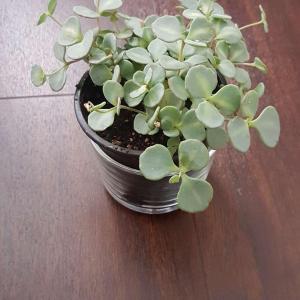
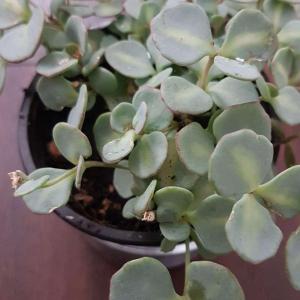


0
0
lottie.elisabeth:@Mnnkiun thank you, I think you're right :)
Mnnkiun:er ..it looks like the Sedum sieboldii. We call it 圆叶景天
文章
Dummer. ゛☀
2017年07月26日

Family - Liliaceae
Stems - Aerial stems to +20cm tall, from short rhizomes, herbaceous, erect, purplish (at least at base), glabrous.
Leaves - Whorled, 3 per plant, sessile, ovate to elliptic, acute to acuminate, glabrous, mottled with silver-green above, to +7cm long, 3.5cm broad, entire.

Inflorescence - Single sessile flower terminating the aerial stem.
Flowers - Petals 3, reddish-maroon (rarely green), lanceolate, attenuate, to +2.5cm long, 8mm broad, glabrous, erect. Stamens 6, +/-1.5cm long. Filaments purple, 2-3mm long. Anthers long, yellow-brown. Styles 3, purple. Ovary superior, 3-6-angled, 3-locular. Placentation axile. Sepals 3, green with reddish margins, lanceolate, to +2.2cm long, glabrous, spreading to erect.


Flowering - April - June.
Habitat - Bottoms, moist slopes, ravines.
Origin - Native to U.S.
Other info. - This fine species can be found mainly in the lower 2/3 of Missouri. The plant is fairly common in the habitats mentioned above.
The plants with green flowers are known as form viridiflorum Beyer and are more rare than the red-flowered form.
The flowers of this species have the slight aroma of dead animal tissue as to attract flies and beetles as pollinators. The plant is edible but should not be picked as most plants in this genus are having a tough time competing with man for living space.
Stems - Aerial stems to +20cm tall, from short rhizomes, herbaceous, erect, purplish (at least at base), glabrous.
Leaves - Whorled, 3 per plant, sessile, ovate to elliptic, acute to acuminate, glabrous, mottled with silver-green above, to +7cm long, 3.5cm broad, entire.

Inflorescence - Single sessile flower terminating the aerial stem.
Flowers - Petals 3, reddish-maroon (rarely green), lanceolate, attenuate, to +2.5cm long, 8mm broad, glabrous, erect. Stamens 6, +/-1.5cm long. Filaments purple, 2-3mm long. Anthers long, yellow-brown. Styles 3, purple. Ovary superior, 3-6-angled, 3-locular. Placentation axile. Sepals 3, green with reddish margins, lanceolate, to +2.2cm long, glabrous, spreading to erect.


Flowering - April - June.
Habitat - Bottoms, moist slopes, ravines.
Origin - Native to U.S.
Other info. - This fine species can be found mainly in the lower 2/3 of Missouri. The plant is fairly common in the habitats mentioned above.
The plants with green flowers are known as form viridiflorum Beyer and are more rare than the red-flowered form.
The flowers of this species have the slight aroma of dead animal tissue as to attract flies and beetles as pollinators. The plant is edible but should not be picked as most plants in this genus are having a tough time competing with man for living space.
0
0
求助
Aijia Teoh
2017年07月25日

Can anyone help with the name of this plant? thanks

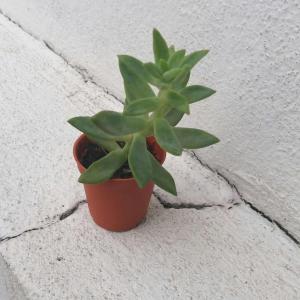


0
0
Abby Gill:Looks like some kind of pachyphytum, but I may be wrong.
文章
Dummer. ゛☀
2017年07月24日

Family - Fabaceae.
Flowering - March - May.
Habitat - Open woods, thickets, glades, rocky stream banks, bluffs, also cultivated.
Origin - Native to U.S.
Other info. - This striking tree is found throughout Missouri. The plant is widely cultivated and is one of the first trees to bloom in the spring. The flowers of C. canadensis are typically pinkish but a pure white-flowered form can also be found.

The flowers of this species are edible and can be eaten raw or cooked. The immature fruits can be fried and eaten also. The inner bark of the tree is an astringent.

Flowering - March - May.
Habitat - Open woods, thickets, glades, rocky stream banks, bluffs, also cultivated.
Origin - Native to U.S.
Other info. - This striking tree is found throughout Missouri. The plant is widely cultivated and is one of the first trees to bloom in the spring. The flowers of C. canadensis are typically pinkish but a pure white-flowered form can also be found.


The flowers of this species are edible and can be eaten raw or cooked. The immature fruits can be fried and eaten also. The inner bark of the tree is an astringent.
0
0
成长记
stureburk
2017年07月23日

Picture from July 14th, when I removed all the chicks from this plant.


2
0
文章
Dummer. ゛☀
2017年07月23日

Family - Lamiaceae
Stems - To 1m tall, erect, herbaceous, purple, 4-angled, from fibrous but tough roots, retrorse pubescent, with a single median vertical groove on each side of the stem. The entire plant fragrant.

Leaves - Opposite, petiolate, decussate. Petioles to +5cm long, antrorse pubescent, purple, with a very shallow adaxial groove. Blades ovate, serrate, acute, to +10cm long, +8cm broad, sometimes crisped or not, typically green above and purple-green or entirely purple below, mostly glabrous above, pubescent on the veins below, with any punctate glands below (use a lens to see). Lateral veins prominent and expressed below.

Inflorescence - Axillary and terminal indeterminate verticillasters to +15cm long. Axis retrorse pubescent (densely), the hairs purple. Flowers 2 at a node, decussate, each subtended by a single folded bract. Bracts broadly ovate when unfolded, entire, 3-5mm long and broad, glabrous but with ciliolate margins. Pedicels 1-2mm long in flower, longer in fruit, pubescent and glandular.
Flowers - Corolla pink, bilabiate, 4mm long, constricted near the base, pubescent externally, with a single band of long hairs at the base of the filaments internally. Upper lip 3-lobed. Central lobe deflexed, rounded, with a single shallow notch, 2-2.2mm broad, 1-1.5mm long. Lateral lobes rounded, 1.5mm broad, 1-1.2mm long, spreading. Lower lip single-lobed, lobe 2-2.3mm broad, 1-1.4mm long, reflexed. Lower lip bearded internally and with 2-4 darker pink spots internally. Stamens 4, adnate in the middle of the corolla tube, alternating with the corolla lobes, slightly exserted. Filaments white, pinkish at the apex, terete, glabrous, 2mm long. Anthers pinkish, fading to purple, bilobed, .5-.7mm broad. Style glabrous, 2-2.4mm long, included under the upper lip of the corolla, white, fading to lilac at the apex, terete. Ovary 4-parted, 1mm broad in flower, subtended by a nectariferous ring. The nectary with a basal appendage that protrudes slightly past the top of the ovary. Calyx bilabiate, the tube to 1.7mm long in flower, dark purple, hirsute externally, with a band of forward-facing hairs internally (at the base of the lobes). Upper lip 3-lobed. Lobes equal, 1.5mm long, 1mm broad, acute. Lower lip 2-lobed. Lobes attenuate, 2-2.2mm long, with antrorse strigose margins or not.

Flowering - August - October.
Habitat - Gravel bars, rich soils, alluvial soils or dry soils along streams, spring branches, gravel bars, roadsides, railroads.
Origin - Native to India.
Other info. - This weedy but showy species can be found mostly in the southern half of Missouri. It is very easy to identify, especially while in flower, as no other plant looks or smells quite like it. The purple stems and distinctive leaves are good characters for identification. The leaves of some plants can be crisped, other may not be. Both types of plants can grow right next to each other and are, at most, phases of the species.
The plant was (is) used traditionally to treat a variety of ailments from diarrhea to morning sickness. It is also used as a culinary herb. This species also produces Perilla oil which is used in food products and also in making lacquers and finishes for wood. Perilla oil is a less expensive substitute for Linseed oil, which comes from another plant, Linum usitatissimum L.
Stems - To 1m tall, erect, herbaceous, purple, 4-angled, from fibrous but tough roots, retrorse pubescent, with a single median vertical groove on each side of the stem. The entire plant fragrant.

Leaves - Opposite, petiolate, decussate. Petioles to +5cm long, antrorse pubescent, purple, with a very shallow adaxial groove. Blades ovate, serrate, acute, to +10cm long, +8cm broad, sometimes crisped or not, typically green above and purple-green or entirely purple below, mostly glabrous above, pubescent on the veins below, with any punctate glands below (use a lens to see). Lateral veins prominent and expressed below.

Inflorescence - Axillary and terminal indeterminate verticillasters to +15cm long. Axis retrorse pubescent (densely), the hairs purple. Flowers 2 at a node, decussate, each subtended by a single folded bract. Bracts broadly ovate when unfolded, entire, 3-5mm long and broad, glabrous but with ciliolate margins. Pedicels 1-2mm long in flower, longer in fruit, pubescent and glandular.
Flowers - Corolla pink, bilabiate, 4mm long, constricted near the base, pubescent externally, with a single band of long hairs at the base of the filaments internally. Upper lip 3-lobed. Central lobe deflexed, rounded, with a single shallow notch, 2-2.2mm broad, 1-1.5mm long. Lateral lobes rounded, 1.5mm broad, 1-1.2mm long, spreading. Lower lip single-lobed, lobe 2-2.3mm broad, 1-1.4mm long, reflexed. Lower lip bearded internally and with 2-4 darker pink spots internally. Stamens 4, adnate in the middle of the corolla tube, alternating with the corolla lobes, slightly exserted. Filaments white, pinkish at the apex, terete, glabrous, 2mm long. Anthers pinkish, fading to purple, bilobed, .5-.7mm broad. Style glabrous, 2-2.4mm long, included under the upper lip of the corolla, white, fading to lilac at the apex, terete. Ovary 4-parted, 1mm broad in flower, subtended by a nectariferous ring. The nectary with a basal appendage that protrudes slightly past the top of the ovary. Calyx bilabiate, the tube to 1.7mm long in flower, dark purple, hirsute externally, with a band of forward-facing hairs internally (at the base of the lobes). Upper lip 3-lobed. Lobes equal, 1.5mm long, 1mm broad, acute. Lower lip 2-lobed. Lobes attenuate, 2-2.2mm long, with antrorse strigose margins or not.

Flowering - August - October.
Habitat - Gravel bars, rich soils, alluvial soils or dry soils along streams, spring branches, gravel bars, roadsides, railroads.
Origin - Native to India.
Other info. - This weedy but showy species can be found mostly in the southern half of Missouri. It is very easy to identify, especially while in flower, as no other plant looks or smells quite like it. The purple stems and distinctive leaves are good characters for identification. The leaves of some plants can be crisped, other may not be. Both types of plants can grow right next to each other and are, at most, phases of the species.
The plant was (is) used traditionally to treat a variety of ailments from diarrhea to morning sickness. It is also used as a culinary herb. This species also produces Perilla oil which is used in food products and also in making lacquers and finishes for wood. Perilla oil is a less expensive substitute for Linseed oil, which comes from another plant, Linum usitatissimum L.
0
0





